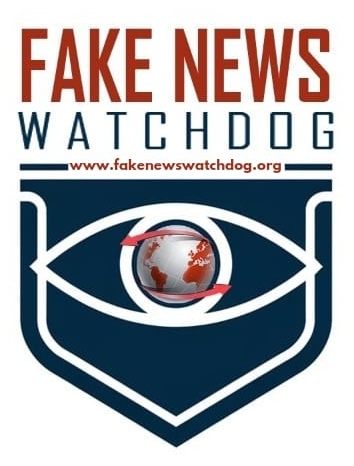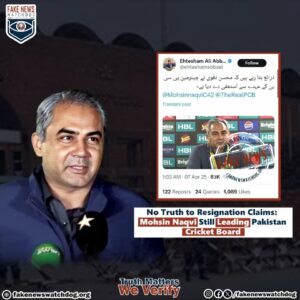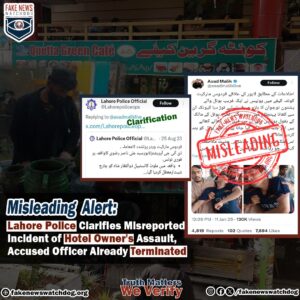Prof. Rehan Hasan
Protecting national interests and unity sounds like a noble and achievable goal, doesn’t it? But national interest and unity, comes at a price. This price often includes losing the full freedom of speech, the uncontrolled flow of information, and the myth of individual responsibility for ensuring truth. We often celebrate freedom of expression, but let’s not fool ourselves. Freedom without responsibility is meaningless. This responsibility is shared by everyone—the journalists who report the news, the politicians shaping narratives, the religious preachers, and even the tech giants designing the algorithms that dictate what we see online. None of them are exempt; all bear some accountability.
Fake news is a term that sounds harmless but represents something deeply destructive. It is not just about spreading lies; it is a dangerous disease that affects every layer of society. “Misleading information” might sound less threatening, but the reality is much worse—it is deliberate deception manufactured as truth. These falsehoods spread through casual conversations, gossip exchanged between neighbors, and sensational headlines designed to provoke rather than inform.
Who remains untouched by this phenomenon? Is anyone immune? The truth is, everyone is affected, from religious leaders to political pundits, from the average citizen to the powerful media executives. Some fall victim unknowingly; others knowingly play a role in the cycle of creating, consuming, and sharing misinformation. Whether it’s misinformation (false information shared without harmful intent), disinformation (falsehoods spread deliberately), or malinformation (truth shared out of context to harm), the web of deceit, call it what you want; it’s a mess, a real problem, and we’re all caught up in it.
So, what can a nation do in the face of this crisis? Responsible media practices and regulatory measures are not optional; they are essential. Without these safeguards, any attempt to preserve national unity becomes another lie— dressed up as truth, waiting to be demolished.
Reading between the lines,
In today’s digital age, where information is everywhere but truth is increasingly rare, the fight against fake news is not just a choice—it is a necessity for survival. Tragic case of Priyantha Kumara, a Sri Lankan factory manager in Sialkot, brutally killed by a mob fueled by false accusations spread online. The lies that led to his murder were never verified, yet they carried enough power to ignite deadly violence. His death not only destroyed a life but also left a scar on our collective conscience. It forced us to confront the deep roots of this problem and the far-reaching consequences of misinformation.
The spread of fake news—whether online or offline—often begins in subtle, quiet ways. It evolves into hoaxes and false narratives that present themselves as truth. Over time, this erodes trust in reliable media, making it harder for people to tell the difference between credible and unreliable sources. The damage spreads like a slow poison, weakening the credibility of journalism and institutions alike. Journalists and media outlets often find themselves caught in this trap—sometimes as victims, other times as unwilling participants. To overcome this crisis, we need more than a casual glance at the problem. We need a thorough investigation into how false information takes shape and why it is so tempting for people to believe and share it.
The challenge is immense, but addressing it is the only way to rebuild trust and protect the values of truth and accountability in society.
جو شاخ نازک پہ آشیانہ بنے گا نا پائیدار ہوگا _ بقول اقبال
A nest built on a delicate branch will not be enduring
(Poet and philosopher Dr Iqbal)
Restoring Trust in the Media
The credibility and survival of media organizations depend on their ability to consistently provide accurate, fair, and reliable information. In the fight against fake news, media houses must lead the way, setting high standards and ensuring accountability. However, in Pakistan, this responsibility is often neglected. While some news outlets occasionally engage in efforts to detect fake news—through investigations or by sharing findings from third-party organizations—these initiatives are infrequent and uncoordinated.
Sadly, many media groups seem more focused on competing with one another than working together to build trust. Instead of collaborating to detect and stop the spread of fake news, they often prioritize discrediting rivals. This rivalry weakens the media’s overall credibility and erodes public trust. Sensationalism and politically driven reporting take precedence over factual, balanced storytelling, further alienating audiences.
To counter this growing crisis of misinformation, the Pakistani media must become a symbol of accountability and integrity. This transformation is not just about survival; it’s about fulfilling their true purpose. Fact-checking should be a fundamental part of journalism, supported by partnerships with independent verification organizations. Media outlets must adopt clear editorial guidelines and publish them openly, setting the standard for themselves and the broader industry.
Persons working in media organizations should be equipped with proper training to identify false narratives and trace misinformation to its source. Transparency in reporting is essential—news, opinions, and advertisements must be clearly distinguished to help audiences navigate content with confidence. Sourcing information accurately and transparently should become the foundation of trust.
One major challenge is the widespread reliance on clickbait. In the race for online views and ad revenue, many media organizations sacrifice integrity for clicks. This dependency must be replaced by more sustainable financial models, such as subscriptions, memberships, and grants. Financial independence is essential to resist external pressures, whether they come in the form of intimidation or incentives. Media organizations must prioritize truth over sensationalism, using tools like artificial intelligence and real-time fact-checking during crises to uncover falsehoods as they arise.
For media outlets that align themselves with government narratives or suppress important stories, the rewards are temporary at best. While they may receive financial benefits or preferential treatment in the short term, their credibility suffers greatly in the long run. Audiences can detect bias and manipulation, and they eventually turn away. Television channels that echo official propaganda often see their ratings plummet because viewers crave authenticity, not scripted narratives.
History shows that controlling the flow of information is never successful in the long term. Silencing dissent does not eliminate it—it forces it to emerge in unpredictable ways. The more truth is suppressed, the more its absence is felt. To rebuild trust and fulfill their essential role in society, the media must rise above short-term gains and focus on delivering what truly matters: accurate, impartial, and trustworthy information.
Combating Misinformation
It began with a single tweet—a blurry image of a burning police van, flames rising into the night sky. The caption claimed: “Protesters shot dead by authorities during a peaceful demonstration against injustice!” Within minutes, the post spread across social media like wildfire. Millions shared it, celebrities amplified it, newsrooms scrambled to cover the story, and political commentators used it as ammunition for their agendas. But there was one major issue: the image was over three years old and unrelated to the protests being discussed.
By the time the truth came out, the damage was already done. Public trust had taken another hit, and the polarized discourse that divides communities had only deepened. For journalists, this incident wasn’t just a mistake—it was a harsh reminder of their responsibility to uphold truth and accuracy. In today’s fast-paced media environment, where being “first” often overshadows being “right,” journalists must navigate their profession with vigilance, skill, and courage.
Media professionals walk a challenging path. They face intense pressure from their organizations to generate views, intimidation from powerful groups, and even harassment from the public. The temptation to cut corners is always present, especially in the race to break news. But compromising integrity comes at a high price. Once trust is lost, it is almost impossible to regain. For those who hold firm to their values, however, the reward is far greater: the preservation of public trust and a meaningful contribution to society.
To combat the spread of misinformation, journalists must follow strict ethical standards. Accuracy, fairness, and impartiality should guide every report. It is essential to resist sensationalism and verify every piece of information, even if it means losing the opportunity to be the first to publish a story. Modern tools like reverse image searches, metadata analysis, and AI-based fact-checking systems can help identify false information in today’s complex digital environment.
Journalists must also build a relationship of trust with their audiences. Being honest about mistakes, correcting errors quickly, and explaining unclear stories can go a long way in restoring credibility. Understanding how misinformation spreads—its sources, its amplifiers, and its consequences—is equally important. Newsrooms must address internal practices that prioritize speed over accuracy and encourage a culture of accountability and ethical reporting.
Providing more than just headlines is another crucial step. Journalists need to offer context and background to help the public fully understand an issue. Safeguarding the identity of confidential sources and openly disclosing any conflicts of interest are key parts of ethical reporting. Collaboration between media organizations is also necessary to fight the larger problem of misinformation. Joint investigations, shared resources for fact-checking, and cross-organizational training programs can strengthen the fight against fake news.
The role of journalists goes beyond reporting news. It is a commitment to protecting society by ensuring the truth is told. Truth is fragile, easily overshadowed by lies and distortions. But with diligence, courage, and ethical rigor, it can be defended. Every headline and every click carry the weight of public trust. Journalists must choose wisely—because their choices shape the public’s understanding of the world.
A Shared Responsibility
Misinformation is like a poison that silently spreads through society, causing chaos, confusion, and even destruction wherever it reaches. It affects everyone—whether they are guilty, unaware, or indifferent. In the end, everyone feels the consequences, although not equally. A person with a keyboard and an unverified opinion faces different consequences than a leader standing at a podium with the power to influence millions.
Misinformation weighs heavily on institutions, weakens governments, and misleads individuals. People become angry, confused, and divided, often turning against one another. However, the biggest responsibility lies with those in power—leaders, organizations, and institutions that have the resources, influence, and duty to fix not only their mistakes but also the damage caused by others. When these authorities remain silent, fail to act, or turn a blind eye, they become just as guilty as those who spread the initial falsehoods. The real question is not just about who started the problem but who will step up to solve it—if anyone even can.
How Media Control Evolved
In the past, governments controlled the media using subtle but powerful methods to silence dissent. Newspapers that didn’t follow the official narrative often faced economic punishment. Distribution channels, such as trains and airplanes owned by the state, were blocked. Limits were placed on the amount of newsprint they can import, and government advertisements—an important source of income for many newspapers—were withheld. Journalists were excluded from official events and press conferences, making it nearly impossible for them to operate. This was not outright censorship but control through isolation, making it hard for independent media to survive. Today, these tactics have been updated for the digital age. Governments may cut internet access, pressure newsrooms to follow unofficial “guidelines,” and target dissenters on social media by labeling them as subversive or prosecuting them. Tools like VPNs, used to bypass internet restrictions, are monitored or banned, and alternative ways to communicate often come with legal risks.
However, these strategies rarely succeed. History shows that suppressing information often backfires, fueling greater dissent and mistrust. Attempts to block information create cracks through which the truth eventually emerges, leaving governments to deal with an even more skeptical and frustrated public.
Governments play a key role in fighting fake news, but they must strike a balance between regulation and protecting freedom of speech. Many governments have introduced laws and policies to curb misinformation, especially online. These measures often focus on stopping the creation and spread of fake news, collaborating with social media platforms to monitor content and track offenders. Public awareness campaigns are also launched to warn citizens about the dangers of spreading false information.
While these steps are important, the same laws can also be misused to silence independent journalism and suppress public debate. Instead of promoting truth and transparency, they sometimes create fear. Journalists and media organizations may self-censor to avoid punishment, while the actual problem of misinformation remains unsolved.
The fight against fake news requires careful planning and accountability from everyone involved. Governments must enforce policies fairly, without targeting critics or limiting free speech. Media organizations must prioritize accuracy and ethical reporting. Public awareness and digital literacy programs should empower people to verify information before sharing it.
Most importantly, the tools meant to combat misinformation must not become weapons of control. A society can only thrive when the truth is valued, freedom of expression is protected, and those in power take their responsibility seriously
To address the issue of misinformation effectively, governments must carefully examine how their legislative actions impact media practices. It is important to determine whether these laws genuinely reduce fake news or if they instead weaken media independence. Rather than resorting to unilateral control, governments should promote collaboration among different groups, including tech companies, independent fact-checkers, civil society, and academic institutions, to find lasting solutions to the misinformation crisis.
Providing funding and institutional support to independent fact-checking organizations can make a significant difference. However, this support must remain free from political interference to preserve both credibility and effectiveness. Independence is crucial to ensure that fact-checkers can hold all parties accountable—whether they are in government, the media, or the general public. Without such autonomy, these efforts risk being undermined by bias or influence.
Governments must strike a careful balance between addressing misinformation while protecting freedom of expression. Laws should emphasize transparency, accountability, and clear rules to prevent misuse. At the same time, educating the public and strengthening independent media should be central to long-term strategies. Without these measures, the fight against fake news could easily become a battle against free speech itself.
The most important responsibility of any government is to create a culture of transparency and openness. This means confronting mistakes honestly and taking swift action to correct them. Mistakes are inevitable because governments, like all human institutions, are prone to error. However, hiding these mistakes—through denial, delays, or public manipulation—only worsens the situation. The longer a lie is left to grow, the more damage it does, spreading distrust and weakening the public’s faith in leadership.
Admitting faults does not make a government weaker; instead, it strengthens public trust and preserves its legitimacy. A prompt acknowledgment, an honest explanation, and concrete steps to fix the issue can prevent small errors from turning into major crises. The real danger is not in making mistakes but in covering them up. When power seeks to hide its failures, it creates a vacuum where mistrust and disillusionment thrive. The longer the silence or denial lasts, the greater the consequences, until the weight of dishonesty eventually crushes governance, credibility, and public trust.
Civil Society
Giving people the knowledge and tools to fight misinformation is crucial for a future where fake news loses its power over individuals and communities. A society that can resist misinformation is one where fake news is quickly spotted and neutralized through thoughtful, informed discussions. Activists and civil society organizations have an important role to play in this effort. Their strong connections with local communities and their ability to engage at the grassroots level make them effective in holding both governments and media accountable while addressing fake news directly.
To strengthen this fight, building a network of watchdog groups at the community, provincial, and national levels is essential. These groups can monitor and identify fake news, work with fact-checking organizations to verify information, and report it to the appropriate platforms or authorities. Additionally, these organizations should focus on education—helping people understand the dangers of fake news and the importance of thinking critically before sharing information. Through media literacy workshops and easy-to-use tools, individuals can learn how to spot misinformation and contribute to meaningful, informed conversations.
Civil society groups must also push for stronger rules and industry standards to tackle fake news. This includes advocating for transparency in political advertisements and campaign funding. Such efforts would help ensure accountability, especially in times when misinformation is used to manipulate public opinion.
Community-led initiatives like iVerify or Fake News Watchdog can also increase public participation in fighting misinformation. Sharing success stories from these projects—where local communities worked together to counter fake news—should be promoted through media. These examples inspire others and show the real impact of collective action. By encouraging shared responsibility and teaching people the skills to counter misinformation, society can build a strong shield against the ever-changing challenges of the digital world.
Academia
To fully understand the complexities of misinformation in the digital age and develop practical strategies to combat it, academics must step out of their isolated world of disconnected theories and engage directly with the realities of the problem. Universities and research institutions have a dual role, to uncover how fake news spreads and operates, and to prepare future generations with the critical thinking skills needed to resist its harmful effects. The algorithms driving social media platforms—the unseen forces behind viral content—spread falsehoods with alarming speed and efficiency. This raises a pressing question: how can we hold platforms accountable? Social media companies, often motivated by profit and operating under opaque policies, must be monitored, regulated, and made to take responsibility for reducing the spread of misinformation. However, this effort will fail unless citizens are digitally literate and capable of distinguishing fact from fiction. Academic institutions must lead this cause.
For universities to meet this challenge, they must rethink their approach. Traditional theories of communication, once reliable, are no longer enough in today’s fast-paced digital landscape. What is needed is applied research—research that steps out of the confines of libraries and lecture halls to confront the real-world consequences of misinformation. Scholars must immerse themselves in the lives of those affected by fake news, examine industries that profit from it, and study the institutions that spread it. Only by doing so can they truly understand the scale of the issue and its impact on society.
Academics should focus on studies that reveal how fake news affects people psychologically, politically, and economically. Their research should guide public policy and shape public discussions. Media literacy and critical thinking need to be taught as essential skills at all levels of education, from primary schools to universities. Workshops, community programs, and public seminars can help academics extend their reach, empowering citizens to navigate the digital world safely and responsibly.
Universities should also act as neutral spaces for dialogue, fostering collaboration with media organizations. By pooling resources and knowledge through joint research and experimental projects, both sectors can create innovative solutions to the problem of fake news. However, this will require scholars to abandon abstract theorizing and actively engage with the challenges of misinformation. It is a difficult and often frustrating task, but it is essential to bring truth and trust back into a world where lies spread so easily.



